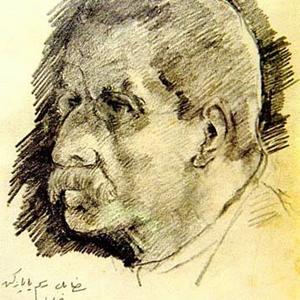

Hoca Ali Rıza
Hoca Ali Rıza was a Turkish painter. A member of the Soldier Painter Generation, Hoca Ali Rıza was the teacher of the 1914 Generation painters.
The painter, who was born in Üsküdar and lived in Üsküdar throughout his life; painted the quiet corners, coastal cafes and sunny cliffs of Üsküdar and Karacaahmet; he was known as “ Hoca Ali Rıza from Üsküdar ”. He is the first Turkish painter to leave the palace gardens and paint in the countryside and on the coast like an impressionist . He produced thousands of works with his proficiency in charcoal and watercolor techniques and his fast working tempo. It is estimated that the number of his works is around five thousand paintings . The artist was the president of the Ottoman Painters Society between 1909-1912 .
He was born in the Ahmediye Neighborhood of the Üsküdar district in 1858. His father was Cavalry Major Mehmet Rüştü Bey. He lost his father, an amateur calligrapher, when he was seven years old.
After studying at Üsküdar Rüştiye, he entered Kuleli Askeri İdadisi ( Kuleli Military High School ) in 1880. While studying at the school, he and five or six friends who were interested in painting like him, submitted a petition to Edhem Pasha, the Minister of Military Schools at the time, and pioneered the opening of a painting studio at the school. Upon this application, he took painting lessons from Mehmet Nuri Pasha, who was assigned to the school. His work was awarded the Nişan-i Mecidi by Sultan II. Abdülhamid the following year. With this encouragement, Rıza Bey and his friends, who even spent their vacation months painting, also benefited from Colonel Süleyman Seyyid Bey, who had studied painting in France and returned to Istanbul, and a French painter named Mösye Gués, who was in Istanbul at the time.
He continued his education at the Harbiye- i Şahane and became a student of Osman Nuri Pasha in this school . He graduated from the Harbiye's " Menşe-i Muallim " program with the rank of Infantry Lieutenant in 1884 and was appointed as the assistant of his teacher Osman Nuri Pasha.
Due to his success during his student years, it was decided to send him to Naples to receive art training, but this decision was abandoned due to the cholera epidemic in Naples. He developed his knowledge of drawing by drawing a glass, a shoe or a table while sitting. He prepared three model albums with thirty examples to help with art classes in military schools. These printed albums played a major role in the spread of art to secondary schools of that period. In addition to these works, he also prepared models for civilian schools. These albums, each with twenty-four pictures, were printed in Istanbul.
In 1891, he joined a committee that conducted research in the first capitals of the Ottoman Empire and recorded the views of Turkish-Islamic works in his notebooks.
In 1895, while he was in the rank of Kolağası, he made porcelain designs at the Yıldız Porcelain Factory . The artist, who met Fausto Zonaro in the same year, made paintings in Değirmendere in 1897.
In 1897, he worked on battle-themed paintings depicting the Turkish- Greek war. In 1903, upon the request of Mahmut Şevket Pasha , he participated in an album work covering " Old Ottoman " clothing. The artist, who was assigned to the commission formed for the establishment of the Turkish Artifacts Museum in 1903, worked for two years at the Harbiye Printing House, where he started as the Chief Painter in 1909.
While serving as the President of the Ottoman Painters Society between 1909 and 1912 , he organized a painting exhibition at the Üsküdar Iskele Casino in 1909. He took the initiative to publish a monthly magazine called the Ottoman Painters Society Newspaper as the society's publication organ.
Hoca Ali Rıza, who taught in the classes of Şehzadegan in 1910, requested retirement from the Military Academy in 1911 due to his deteriorating health condition and retired with the rank of Lieutenant Colonel.
After leaving the military school, he tried to support himself by teaching art in some schools. In 1914, he worked as a landscape teacher at the İnas School of Fine Arts . In 1917, he was elected as a member of the Board of Fine Arts, which was affiliated with the Ministry of Education . In 1918, he started teaching art at the Çamlıca İnas Sultanisi ( Çamlıca Girls High School ) for three years. In 1921, he became an art teacher at the Üsküdar School of Fine Arts and in 1929, he taught at the Sultanahmet Boys' Ameli Hayat School. He gave his most important works in Turkish painting to his retirement years. Although he was in financial difficulties, Hoca Ali Rıza never sold his paintings and only gave his paintings as gifts to his loved ones.
With his proficiency in charcoal and watercolor techniques and his fast working tempo, the artist depicted numerous Istanbul landscapes (reaching a number of around five thousand), interpreting the city's neighborhoods, neighborhood life from Üsküdar to Bebek , Arnavutköy to Burgazada , coffeehouses, and seasides. He died in Üsküdar on March 20, 1930. His grave is in Karacaahmet.
